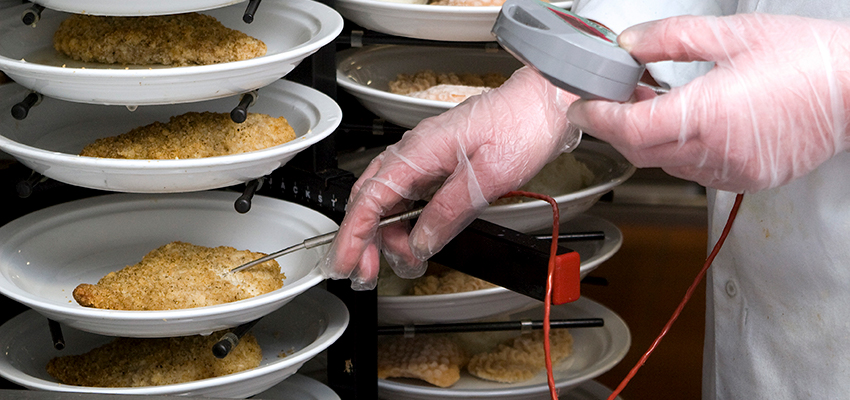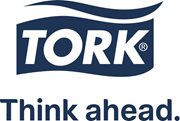Articles
August 31, 2023
Keep foods out of the temperature danger zone
National Food Safety Month kicks off with the importance of time and temperature in food prep and why it’s a critical control point in your food safety procedures.

When your kitchen staff lets food sit out for extended periods of time, bacteria can multiply.
Any type of food can become contaminated, but bacteria grow even more rapidly on certain types of food. The range between 41°F and 135°F is referred to as the temperature danger zone—the range in which bacteria grow most rapidly in food.
More specifically, bacteria multiply the fastest between 70°F and 125°F.
The longer food sits in the danger zone, the higher the risk that bacteria will grow. When kitchen pros consistently monitor the time food spends in the temperature danger zone, they’re controlling time and temperature for safety.
Consider this scenario: A prep cook pulls every ingredient he needs to make and assemble 200 chicken salad sandwiches: chicken, mayo, mustard, seasonings, garnishes, bread, etc. All the ingredients sit in the kitchen’s ambient temperature for a couple of hours before he returns the assembled sandwiches to cold storage.
A second prep cook pulls only enough ingredients he can make, assemble and return to cold storage in less than two hours, using a batch approach so that cold ingredients are kept cold and are not left sitting out. He makes the chicken salad first (in batches, returning them to the walk-in), preps all garnishes next (in batches, returning them to the walk-in), and finally assembles the sandwiches—in batches.
Which is the safer approach?
Foods that need time and temperature control for safety
The foods that are at the highest risk of rapid bacteria growth are called “time and temperature control for safety,” or TCS foods. The most common are:
Training staff on how to cook foods to their proper internal temperatures helps protect the health and safety of your guests, while ensuring your staff follows a consistent and reliable temperature monitoring procedure.
All food handlers and managers should be educated on your food-safe cooking policy and be held accountable to follow it diligently. A time and temperature poster would be helpful displayed in the kitchen.
A strong food cooking policy consists of:
Check back next week for another essential NFSM 2023 topic that will help keep your food safe and your guests healthy—personal hygiene. Make sure you check out foodsafetyfocus.com throughout the month, as the Association will be posting various checklists, eBooks, posters, and other NFSM 2023 printable content you won’t want to miss. Check out discounts on ServSafe training products this month, too.
Any type of food can become contaminated, but bacteria grow even more rapidly on certain types of food. The range between 41°F and 135°F is referred to as the temperature danger zone—the range in which bacteria grow most rapidly in food.
More specifically, bacteria multiply the fastest between 70°F and 125°F.
The longer food sits in the danger zone, the higher the risk that bacteria will grow. When kitchen pros consistently monitor the time food spends in the temperature danger zone, they’re controlling time and temperature for safety.
Consider this scenario: A prep cook pulls every ingredient he needs to make and assemble 200 chicken salad sandwiches: chicken, mayo, mustard, seasonings, garnishes, bread, etc. All the ingredients sit in the kitchen’s ambient temperature for a couple of hours before he returns the assembled sandwiches to cold storage.
A second prep cook pulls only enough ingredients he can make, assemble and return to cold storage in less than two hours, using a batch approach so that cold ingredients are kept cold and are not left sitting out. He makes the chicken salad first (in batches, returning them to the walk-in), preps all garnishes next (in batches, returning them to the walk-in), and finally assembles the sandwiches—in batches.
Which is the safer approach?
Foods that need time and temperature control for safety
The foods that are at the highest risk of rapid bacteria growth are called “time and temperature control for safety,” or TCS foods. The most common are:
- Milk and dairy products
- Shell eggs
- Poultry, beef, pork, and lamb
- Fish, shellfish, and crustaceans
- Baked potatoes
- Heat-treated plant food such as cooked rice, beans, and vegetables
- Tofu and other soy protein
- Synthetic ingredients such as textured soy protein in meat alternatives
- Sliced melons, cut tomatoes, cut leafy greens
- Sprouts and sprout seeds
- Untreated garlic-and-oil mixtures
Learn more about TCS foods and how to safely cook, cool, reheat, hot-hold, and store TCS foods, in Cracking the Code on Food Time and Temperature.
How to measure temperature
From the moment food arrives at your back door, right up until the time you serve it, temperature should be consistently monitored using correctly calibrated thermometers. Kitchen staff should log food temperatures regularly, either by hand or with kitchen software that automatically records temps.
A few guidelines:
- Always wash, rinse, sanitize, and air-dry your thermometer before every use.
- Ensure your thermometer is calibrated to read temperatures correctly.
- There are different kinds of thermometers for different tasks—use the correct thermometer for the job you’re doing.
- Check temperature by sticking the thermometer into the thickest section of the food.
- Wait until the thermometer reading remains steady before recording a temperature.
- Take a second reading in a different section of the food.
- Wash, rinse, sanitize, and air-dry the thermometer immediately after use. Store in a clean case.
Training staff on how to cook foods to their proper internal temperatures helps protect the health and safety of your guests, while ensuring your staff follows a consistent and reliable temperature monitoring procedure.
All food handlers and managers should be educated on your food-safe cooking policy and be held accountable to follow it diligently. A time and temperature poster would be helpful displayed in the kitchen.
A strong food cooking policy consists of:
- Purpose: Briefly explain what this policy accomplishes in terms of food safety.
- Scope: Identify which members of your staff this policy applies to.
- Procedure: Thoroughly lay out procedures for staff to safely prepare and cook food; list and make available specific temperatures to reach when cooking, cooling, and holding TCS food.
- Monitoring: List the procedures for properly using a thermometer to regularly check and record food temperatures.
- Corrective action: Explain the correct actions to take when food fails to reach minimum internal temperature or stays in the temperature danger zone for too long.
- Record keeping: List all the requirements for staff to keep records of food temperatures.
Check back next week for another essential NFSM 2023 topic that will help keep your food safe and your guests healthy—personal hygiene. Make sure you check out foodsafetyfocus.com throughout the month, as the Association will be posting various checklists, eBooks, posters, and other NFSM 2023 printable content you won’t want to miss. Check out discounts on ServSafe training products this month, too.
Supported by
-
Tork
![]() TorkThe Tork brand offers professional hygiene products and services to customers worldwide ranging from restaurants and healthcare facilities to offices, schools, and industries. Our products include dispensers, paper towels, toilet tissues, soap, napkins, and wipers, but also software solutions for data-driven cleaning. Through expertise in hygiene, functional design, and sustainability, Tork has become a market leader that supports customers to think ahead so they're always ready for business. Tork is a global brand of Essity and a committed partner to customers in over 110 countries. To keep up with the latest Tork news and innovations, please visit www.torkusa.com
TorkThe Tork brand offers professional hygiene products and services to customers worldwide ranging from restaurants and healthcare facilities to offices, schools, and industries. Our products include dispensers, paper towels, toilet tissues, soap, napkins, and wipers, but also software solutions for data-driven cleaning. Through expertise in hygiene, functional design, and sustainability, Tork has become a market leader that supports customers to think ahead so they're always ready for business. Tork is a global brand of Essity and a committed partner to customers in over 110 countries. To keep up with the latest Tork news and innovations, please visit www.torkusa.com
